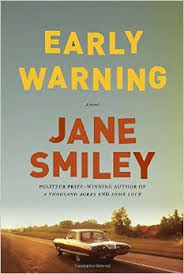Early Warning: A Novel
- By Jane Smiley
- Alfred A. Knopf
- 496 pp.
- Reviewed by Barbara Esstman
- May 8, 2015
This densely populated family saga aims to be more than the sum of its parts.

Early Warning, the middle novel of Jane Smiley’s projected familial trilogy that began with Some Luck, opens with the funeral of Walter, the patriarch of the Langdon clan. It is 1953. The family gathers for a five-page wake.
For the next six pages Frank, Walter’s eldest son, runs a clandestine errand to Iran on behalf of his brother-in-law and probably the CIA, and for the four pages following that Frank’s brother Henry suffers his unrequited love for his mother’s niece Rosa.
Then it is 1954. And so it goes, as Kurt Vonnegut would say, for almost 500 more pages, numerous other family members, and every year through 1986.
Smiley’s writing is gorgeous, and readers can find pleasure simply in reading such well-crafted lines as, “Might be ninety-eight in the shade. The weather had been doomfully good, and you really could hear the corn grow this time of year, if you could stand it.”
Each individual section is so rich in detail and texture that the living world of the book can be entered and experienced, like this description of growing up on the family farm in Denby, Iowa: “Opa had raised them on stories of flocks of turkeys, flights of ducks, waves of prairie chickens, and even cougars slinking past the window in the night, heading for the sheep in the pen.”
Many will also love the wide scope of a family saga that in this volume covers four generations and touches lightly on the major historical events of those times — the overthrow of Iranian Prime Minister Mohammad Mosaddegh, the assassination of John F. Kennedy, the mass suicide of Jim Jones’ followers in Guyana, and other moments prominent in our country’s memory. The array of issues facing the characters covers an even wider scope, from births and deaths to more specialized concerns such as cancer, depression, and coming out, all set within the complicated webbing of relationships in a large, extended family.
But here are my early warnings for readers. The forward motion of this book rests on the calendar progression of years, not on a conventionally focused plot with tension, continuity, and resolution. While each short section is well-written, most are missing the conflict of a true scene that would move the action forward. Often, a character’s internal struggle, if examined at all, is withheld and summarized only after the problem is resolved, which diffuses the engagement and momentum readers gain with a more traditional dramatic structure.
The number of characters alone presents a challenge in just keeping the multitude straight, let alone caring what happens to them. Since the book’s episodic structure leaves long stretches (sometimes many years) during which individual characters are MIA, readers must reboot each time these people reappear in order to recall which branch of the family they belong to, what they were doing when last seen, and how old they are now.
Many of the better sections engage readers in tempting plot lines that terminate abruptly and move on to other characters and situations that do likewise. With no connective tissue to track how characters arrive at certain junctures in their lives, it’s difficult to become involved in their journeys.
While other heavily populated novels such as War and Peace quickly identify the main characters and direct the action, Smiley treats her characters evenhandedly as the ultimate ensemble but with no overarching plot to gather them into a cohesive whole.
Yes, a family tree is provided to sort out the cast of characters, but it’s cumbersome to keep consulting, particularly as more generations are born and given nicknames to further complicate the problem. I spent futile minutes searching the chart for what turned out to be the name of a family dog, and I gave up looking for one character who was intentionally unlisted so as to create the book’s only real mystery.
It seems to me that Smiley is attempting to construct a new novel form that sets the lives of a large family against the sweep of time and records its members’ progression without commentary or other traditional writing techniques like plot.
While the theory is interesting, the application doesn’t take into consideration how human minds work. We tend to forget facts without sufficient frames of reference, confuse people when we meet too many at once, and lose interest if there’s no urgency in finding out what comes next.
But for readers who can ignore their usual expectations for a novel, the lovely mass of material in Early Warning glides peacefully past like a loaded barge on a Midwestern river.
Barbara Esstman, MFA and NEA fellow, is co-editor of A More Perfect Union and author of the novels The Other Anna and Night Ride Home.

